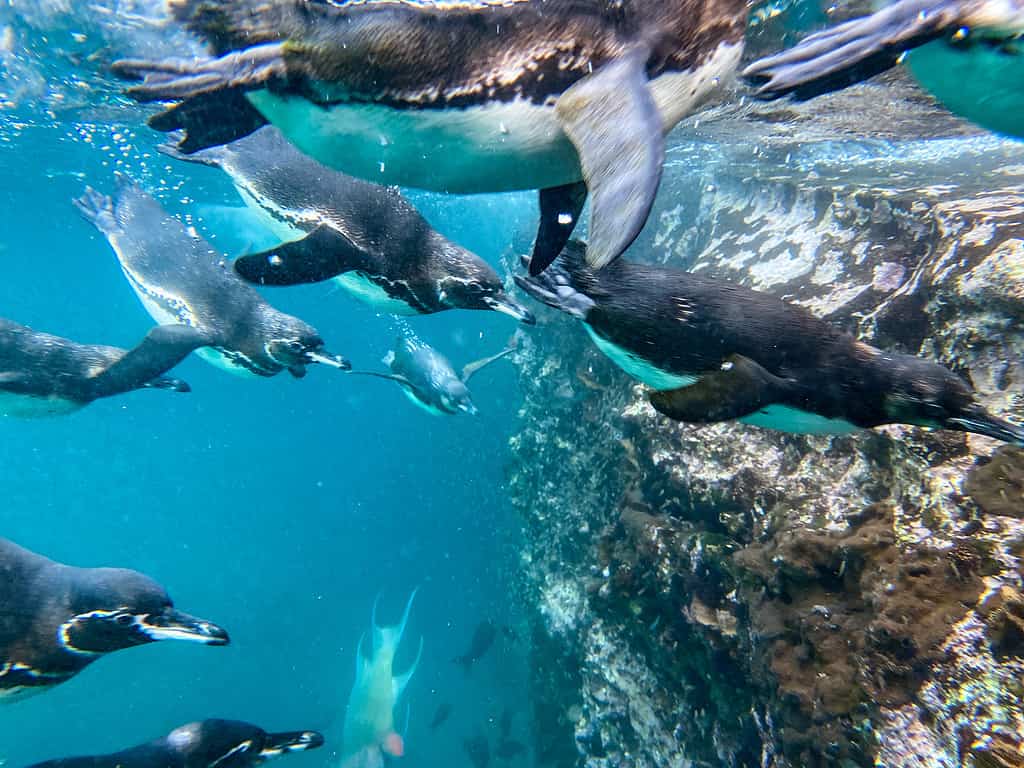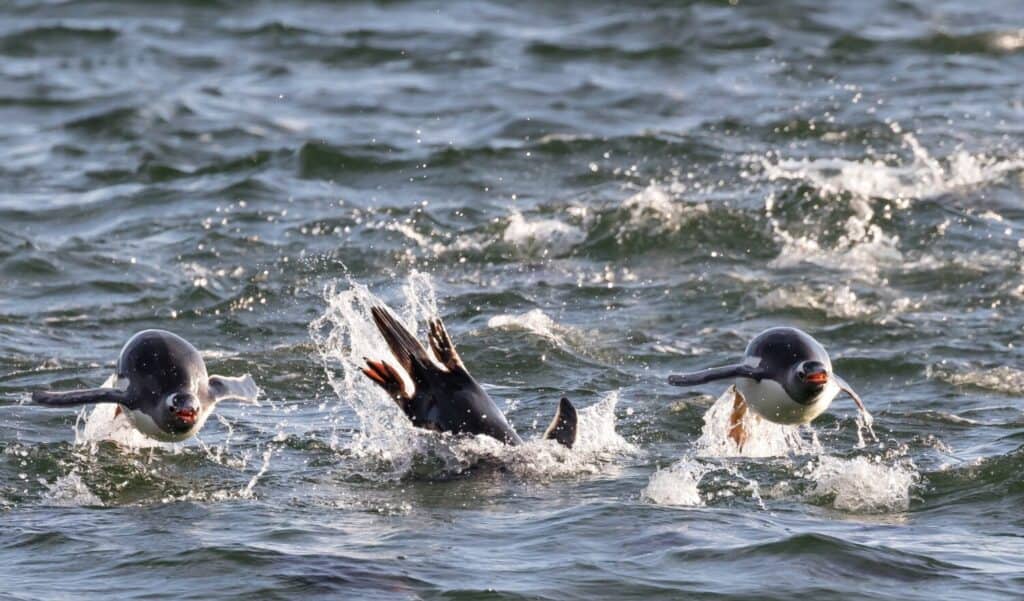Penguins are aquatic acrobats. They slice through the water with astonishing speed.
These speeds can vary among individual penguins and within a species. Other factors such as age, environment, and health also play a role in zipping through the water (just like for humans).
So, let’s dive into the world of these charismatic creatures and uncover the secrets of how fast penguins can swim.
Where Can You Find Penguins?
Penguins are not just Antarctic dwellers. They inhabit diverse regions. From the icy Antarctic to the temperate Galápagos Islands, penguins adapt remarkably.
- Antarctica: Emperor and Adélie penguins brave the harshest cold.
- Galápagos Islands: The Galápagos penguin, the only species found north of the equator.
- South Africa: African penguins grace the coastlines, thriving in warmer waters.
What Do Penguins Eat?
Penguins are skilled hunters. They feast on a diet of fish and krill. But the menu varies.
- Fish: Sardines, anchovies, and lanternfish are popular choices.
- Krill: These tiny shrimp-like crustaceans provide essential nutrients.
- Squid: Some penguin species add squid to their diet for variety.
Speedsters: How Fast Penguins Can Swim

The maximum speed of emperor penguins is between 6 to 8 mph, with an average speed of 2 to 3 mph.
©Michel VIARD/ via Getty Images
Penguins are not just cute and cuddly; they’re speed demons underwater.
- Top Speed: The gentoo penguin takes the lead, reaching speeds up to 22 miles per hour (35 km/h).
- Aerodynamic Bodies: Streamlined bodies help reduce water resistance.
- Strong Flippers: Powerful flippers propel them forward with precision.
King penguins have been recorded with a maximum swim speed of 7.6 mph, although they typically swim from 4 to 5 mph.
Adélie penguins probably reach maximum burst speeds of 18 to 25 mph, but typically swim at about 4.9 mph.
The emperor penguin is the tallest and heaviest of all living penguin species and is endemic to Antarctica. Their maximum speeds are 6 to 8 mph, with an average speed of 2 to 3 mph.
Here’s a table comparing different types of penguins with their average and top swimming speeds.
| Penguin Species | Average Swimming Speed (km/h) | Top Swimming Speed (km/h) |
| Emperor Penguin | 2-3 | 6-8 |
| King Penguin | 1-2 | 6-10 |
| Adélie Penguin | 3-5 | 10-12 |
| Gentoo Penguin | 3-4 | 15-22 |
| Chinstrap Penguin | 3-5 | 10-15 |
| Macaroni Penguin | 3-5 | 15-24 |
| Little Blue Penguin | 1-2 | 6-10 |
| African Penguin | 2-3 | 12-20 |
| Humboldt Penguin | 4-6 | 12-20 |
| Galapagos Penguin | 2-3 | 6-8 |
| Magellanic Penguin | 2-3 | 10-12 |
Individual penguins may swim slightly faster or slower depending on various factors, including age, health, and environmental conditions.
How Do Penguins Achieve Their Impressive Speeds?

Penguins have perfected the art of underwater locomotion.
©Joanne Wastchak/ via Getty Images
Penguins have perfected the art of underwater locomotion.
- Flippers: Short wings evolved into flippers, ideal for maneuverability.
- Hydrodynamic Design: Their bodies are built for minimal drag, enabling swift travel.
- Webbed Feet: Webbed feet act like rudders, aiding direction control.
Penguins and Their Unique Adaptations
These birds are champions of adaptation. They’ve developed some incredible strategies.
- Countershading: Dark backs and white bellies provide camouflage from predators below.
- Heat Retention: A dense layer of feathers trap warm air close to their bodies.
- Salt Excretion: Glands near their eyes help expel excess salt, allowing them to drink seawater.
Penguins Are Social Birds
These birds have a knack for forming close-knit communities.
- Colonies: Penguins gather in large colonies for safety and warmth.
- Social Bonding: Mating pairs often engage in rituals to strengthen their bond.
- Chick Care: Both parents share the responsibility of feeding and caring for their chicks.
Molting: A Tough Time for Penguins
Molting is a challenging period in a penguin’s life.
- Feather Replacement: Penguins shed old feathers and grow new ones.
- Vulnerable Phase: During molting, they can’t swim or hunt, relying on stored fat.
Penguin Predators: Life in the Food Chain

Penguins face constant threats from predators.
©Farjana.rahman/Shutterstock.com
Penguins face a constant battle against various predators.
- Leopard Seals: These stealthy predators hunt penguins in the water.
- Skua Birds: Skuas target penguin eggs and chicks.
- Orcas: Killer whales are skilled hunters of penguins, too.
Penguin Species: Diversity at Its Best
Penguins aren’t a one-size-fits-all species. They come in various shapes and sizes.
- Emperor Penguins: The largest of all, towering at about 4 feet (1.2 meters).
- Little Blue Penguins: The smallest, standing at a mere 1 foot (30 centimeters).
- King Penguins: Recognized by their vibrant orange neck patches.
Penguins’ Remarkable Mating Rituals
Mating rituals are a spectacle in the penguin world.
- Gift Exchange: Male penguins often present pebbles to woo females.
- Monogamy: Many penguin species form lifelong monogamous bonds.
- Nest Building: Elaborate nests are constructed to protect eggs from the cold ground.
Penguins in Peril: Conservation Challenges
Penguins face significant threats to their survival.
- Climate Change: Melting ice affects their hunting grounds and breeding sites.
- Overfishing: Competition for food with the fishing industry puts pressure on penguin populations.
- Oil Spills: Oil contamination harms penguins’ waterproof feathers and food sources.
Penguin Conservation Efforts
Numerous organizations work tirelessly to protect penguins.
- Protected Reserves: Establishing marine reserves safeguards penguin habitats.
- Research and Monitoring: Scientists track penguin populations and behavior.
- Community Involvement: Engaging local communities in conservation efforts is crucial.
Penguins are more than just flightless birds. They are agile underwater athletes. Their remarkable adaptations allow them to thrive in some of the world’s harshest environments.
From their speedy underwater dashes to their elaborate mating rituals, penguins are truly captivating creatures. But they face growing challenges, particularly due to climate change.
To ensure the survival of these charming birds, we must continue to learn about and protect their habitats. Penguins are a testament to the beauty and diversity of the natural world, and it’s our responsibility to ensure they remain a part of it for generations to come.
The photo featured at the top of this post is © David Herraez Calzada/Shutterstock.com
Thank you for reading! Have some feedback for us? Contact the AZ Animals editorial team.






